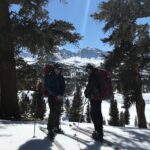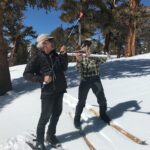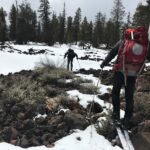The snowpack above the Central Valley looked slightly better after March and April brought the winter weather that was AWOL during the first two months of 2020.
But the late storms weren’t enough to get valley rivers much above the 60%-of-average mark, if that.
San Joaquin River
The storms did provide enough snow for the San Joaquin River to firmly declare a “dry” year.
The designation is serious business for the River Restoration Program, tasked with establishing flows and habitat to reestablish a Chinook salmon population which had all but gone extinct after Friant Dam was built and San Joaquin River water was routed to farms and cities to the south.
Earlier this spring, the water year was in the “critical high” range, which would have limited flows for the restoration program to a meager 71,000 acre feet.
But a dry year designation will give the program, and the salmon, 211,000 acre feet this year, according to Rufino Gonzalez, a project engineer for the Bureau of Reclamation, which runs the restoration program.
The boost to the snowpack also means farmers who take water off the Friant-Kern Canal got an increase in their allocation, which went from 40% to 55% on Tuesday.
Kings River
A little further down the valley, different forecast models and surveys show the Kings River watershed is somewhere between 56% and 63% of average, according to Kings River Watermaster Steve Haugen.
He is hoping to get data from an April 15 Airborne Snow Observatorie flight to help better pin down that percentage.
The ASO is a new tool developed by NASA’s Jet Propulsion Laboratory that uses light detection and ranging technology to measure the depth of the snow in even the most remote reaches of the Sierra Nevadas.
It has been used in a limited number of Central Valley river watersheds over the past four years.
Haugen said, given the current models and surveys, he’s leaning toward a 60% of average runoff, but is hoping the ASO numbers firm that up.
A 60% of average year equals roughly 760,000 acre feet of runoff from now through July. That will work out to 1 million acre feet for the full year.
Combined with about 300,000 acre feet still stored behind Pine Flat Dam, that gives cities and farms that rely on the Kings River 1.3 million acre feet.
Last year, Kings River interests used 2.6 million acre feet, or double what’s expected this year.
“People are gonna have to pump some groundwater,” Haugen acknowledged.
Kern River
On the Kern River, water users can expect a 55% of average year, or 250,000 acre feet of runoff, said Kern River Watermaster Dana Munn.
That’s based on snow surveys done April 1 so later storms may bump that number up a little.
“The snow sensors are showing a healthy accumulation, but it’s not in the model yet,” he said.
Though water managers on the Kings, San Joaquin and other valley rivers are starting to use ASO flights as a regular part of their runoff forecasting, Kern has been a hold out.
That’s because it’s expensive at $90,000 a flight. And the Kern River’s watershed delivers 450,000 acre feet a year on average, Munn said. When Isabella Lake is at full capacity it can store 570,000 acre feet, so there’s less need for detailed snowpack information for potential flood control.
For comparison, Millerton Lake north of Fresno can hold 540,000 acre feet. In big water years, the San Joaquin can bring nearly 2 million acre feet barrelling down the Sierras.
Getting a handle on that watershed’s snowpack makes sense.
But the Kern River interests may be taking a closer look at what ASO offers after the COVID-19 crisis nearly waylaid this year’s snow survey.
Munn said the Kern River group, made up of the City of Bakersfield, Kern County Water Agency, North Kern, Buena Vista, Kern Delta water storage districts, had trouble finding surveyors to measure the snow depth in the river’s rugged watershed.
The trip is a 10-day ordeal in extremely remote areas along the western base of Mount Whitney. Surveyors typically ski in and stay in cabins built in the 1930s.
Some surveyors were worried they would become ill with COVID while in the backcountry, or their family members would become ill while they were unreachable. And they didn’t want to helicopter in, concerned about being in such close of proximity with other people.
“Finally we found some folks who hiked in and got it done,” Munn said.
With ASO, he said, they might not have to have surveyors get into the most remote passes. And, he added, there could be state money to help defray the costs.
If the state were to pay for ASO flights over all of California’s watersheds, it could cost about $15 million a year.
So far, legislative attempts to secure that funding haven’t succeeded.
Share this:
- Click to share on Facebook (Opens in new window)
- Click to share on Twitter (Opens in new window)
- Click to share on LinkedIn (Opens in new window)
- Click to share on Reddit (Opens in new window)
- Click to share on Tumblr (Opens in new window)
- Click to share on Pinterest (Opens in new window)
- Click to share on Pocket (Opens in new window)
- Click to share on Telegram (Opens in new window)
- Click to share on WhatsApp (Opens in new window)
- Click to print (Opens in new window)










You must be logged in to post a comment.